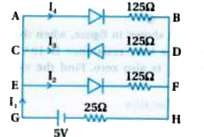In a semiconducting material the mobilities of electrons and holes are and respectively. Which of the following is true? Solution in Gujrati
The correct Answer is:A
In semiconductor as electrons are free and as well as its mass is less so electrons is mobile where as holes are in covalent bond so do not move, therefore .
Topper's Solved these Questions
- BOOK - KUMAR PRAKASHANCHAPTER - SEMICONDUCTOR ELECTRONICS : MATERIALS, DEVICES AND SIMPLE CIRCUITS EXERCISE - Section-D : Multiple Choice Questions (MCQs) (MCQs asked in Competitive Exams)129videos
SEMICONDUCTOR ELECTRONICS : MATERIALS, DEVICES AND SIMPLE CIRCUITS
- BOOK - KUMAR PRAKASHANCHAPTER - SEMICONDUCTOR ELECTRONICS : MATERIALS, DEVICES AND SIMPLE CIRCUITS EXERCISE - Section-C: NCERT Exemplar Solution (Long Answer Type Questions)10videos
SEMICONDUCTOR ELECTRONICS : MATERIALS, DEVICES AND SIMPLE CIRCUITS
- BOOK - KUMAR PRAKASHANCHAPTER - SAMPLE QUESTION PAPER EXERCISE - PART-B SECTION-C5videos
SAMPLE QUESTION PAPER
- BOOK - KUMAR PRAKASHANCHAPTER - WAVE OPTICSEXERCISE - SECTION-D (MULTIPLCE CHOICE QUESTIONS (MCQS)) (MCQS FROM DARPAN BASED ON TEXTBOOK)239videos
WAVE OPTICS
Similar Questions
At absolute zero temperature Si acts as ……..
02:56View Solution
If each diode in figure has a forward bias resistance of 25Ω and infinite resistance in reverse bias, what will be the values of the current I1,I2,I3andI4?03:56View SolutionTwo charges –q and +q are located at points (0, 0, –a) and (0, 0, a), respectively.
(a) What is the electrostatic potential at the points (0, 0, z) and (x, y, 0) ?
(b) Obtain the dependence of potential on the distance r of a point from the origin when r/a>>1 .
(c) How much work is done in moving a small test charge from the point (5,0,0) to (–7,0,0) along the x-axis? Does the answer change if the path of the test charge between the same points is not along the x-axis?04:48View SolutionAccording to particle theory of light what is the velocity of light in a dense medium, compared to that in rare medium ?
02:58View SolutionIn a semiconducting material the mobilities of electrons and holes are μe and μh respectively. Which of the following is true?
07:10View SolutionA semiconductor having electron and linear mobilities mu_(n) and mu_(p) respectively. If its intrinsic carrier density is n_(i) , then what will be the value of hole concentration P for which the conductivity will be maximum at a given temperature?
04:47View Solutionयदि प्रतिचुम्बकीय , अनुचुम्बकीय तथा लौह - चुम्बकीय पदार्थों के चुम्बकीय द्विध्रुव आघूर्ण क्रमशः μd,μb तथा μp से व्यक्त किये जाते हो तो-
01:24View SolutionIn a semiconducting material the mobilities of electrons and holes are mu_(e) and mu_(h) respectively. Which of the following is true ?
01:24View SolutionIf mu_(O) and mu_(E ) be the refractive indices of the crystal for O-ray and E-ray respectively, then which of the following relations is correct for negative crystal
04:31View SolutionIf refractive indices of a positive crystal for O-ray and E-ray are μoandμE respectively, then μE will be ____ than μo [ Fill in the blank].
02:58View SolutionIf the magnetic dipole of moment of an atom of diamagnetic material, paramagnetic material and ferromagnetic material are donated by μd,μp and μf respectively, then:
01:36View SolutionIf the magnetic dipole of moment of an atom of diamagnetic material, paramagnetic material and ferromagnetic material are donated by μd,μp and μf respectively, then:
View SolutionThe refractive indices of three media 1,2 and 3 and mu_(1),mu_(2) and mu_(3) respectively (mu_(1) gt mu_(2) gt mu_(3)) . Which of the following statements are correct?
08:08View SolutionIf the magnetic dipole moment of an atom of dimagnetic material paramagnetic material and ferromagnetic material are denoted by μdμp and μf respectively then
02:13View SolutionIn a semiconducting material the mobilities of electrons and holes are, mu_e and mu_h respectively. Which of the following is true?
03:38View Solution

